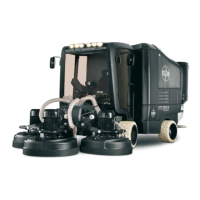44 SEBU7833-03
Maintenance Section
Refill Capacities
(Table 14, contd)
Copper Strip
Corrosion
No. 3 maximum
“D130”
10% at 282 °C
(540 °F)
maximum
Distillation
90% at 360 °C
(680 °F)
maximum
“D86”
Flash Point legal limit
“D93”
30 minimum
API Gravity
45 maximum
“D287”
Pour Point
6°C(10°F)
minimum
below ambient
temperature
“D97”
Sulfur
(1)
0.2% maximum “D3605”
or
“D1552”
Kinematic
Viscosity
(2)
2.0 cSt minimum
and 4.5 cSt
maximum at
40 °C (104 °F)
“D445”
Water and
Sediment
0.1% maximum
“D1796”
Water
0.1% maximum “D1744”
Sediment
0.05% maximum
(weight)
“D473”
Gum and Resins
(3)
10 mg per 100
mL maximum
“D381”
Lubricity
(4)
0.38 mm
(0.015 inch)
maximum at
25 °C (77 °F)
“D6079”
(1)
Perkins fuel systems and engine com ponents can operate
on high sulfur fuels. Fuel sulfur levels affect exhaust
emissions. High sulfur fuels also increase the potential
for corrosion of inte rnal com ponents. Fuel sulfur levels
above 0.5 percent ma y significantly s horten the oil chang e
interval. For additional information, see this publication, “Fluid
Recommendations/Engine Oil” topic (Maintenance Section).
(2)
The values o f the fuel viscosity are the values as the fuel
is delivered to the fuel injection pumps. If a fuel with a low
viscosity is used, cooling of the fuel may be required to maintain
a 1.4 cS t viscosity at the fuel injection pump. Fuels with a high
viscosity might require fuel heaters in order to bring down the
viscos ity to a 20 cSt viscosity.
(3)
Follow the test conditions and pr ocedures for gasoline (motor).
(4)
The lubricity of a fuel is a concern with low sulfur fuel. To
determine the lubricity of the fuel, use either the “ASTM D60 78
Scuffing Load Wear Test (SBOCLE)” or the “ASTM D6079 High
Frequency Reciprocating R ig (HFRR)” test. If the lubricity of a
fuel does not m eet the minimum requirements, consult your
fuel supplier. Do not treat the fuel without consulting the f uel
supplier. Some additives are not c ompatible. These additives
can cause problem s in t he fuel system.
NOTICE
Operating with
fuels that do not meet the Perkins rec-
ommendations can cause the following effects: Start-
ing difficulty, poor combustion, deposits in the fuel in-
jectors, redu
ced service life of the fuel system, de-
posits in the combustion chamber, and reduced ser-
vice life of the engine.
NOTICE
Heavy Fuel Oil (HFO), Residual fuel, or Blended fuel
must NOT be used in Perkins diesel engines. Severe
component wear and component failures will result if
HFO type fuels are used in engines that are configured
to use distillate fuel.
In extreme cold ambient conditions, you may use the
distillate fuels that are specified in Table 15. However,
the fuel that is selected must meet the requirements
that are specified in Table 14. These fuels are
intended to be used in operating temperatures that
are down to −54 °C (−65 °F).
Table 15
Distillate Fuels
(1)
Specification Grade
“MIL-T-5624R” JP-5
“ASTM D1655” Jet-A-1
“MIL-T-83133D” JP-8
(1)
The fuels that are listed in this Table may not m eet the
requirements that a re specifie d in the “P erkins Specifications
for Distillate Diesel Fuel” Ta ble. Consult the supplier for the
recommended additives in order to m aintain the correct fuel
lubricity.
These fuels are lighter than the No. 2 grades of fuel.
The cetane number of the fuels in Table 15 must be
at least 40. If the viscosity is below 1.4 cSt at 38 °C
(100 °F), use the fuel only in temperatures below
0°C(32°F).Donotuseanyfuelswithaviscosity
of less than 1.2 cSt at 38 °C (100 °F). Fuel cooling
may be required in order to maintain the minimum
viscosity of 1.4 cSt at the fuel injection pump.
There are many other diesel fuel specifications that
are published by governments and by technological
societies. Usually, those specifications do not
review all the requirements that are addressed
in this specification. To ensure optimum engine
performance, a complete fuel analysis should be
obtained before engine operation. The fuel analysis
should include all of the properties that are listed in
Table 14.
This document is printed from SPI². Not for Resale.

